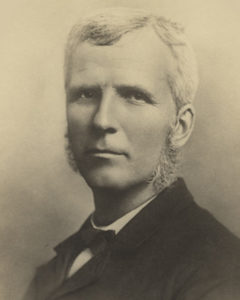
Samuel Armstrong
*Samuel Armstrong was born on this date in 1839. He was a white-American soldier, educator, abolitionist, and administrator.
The third son of Christian missionary Richard Armstrong, Samuel Chapman Armstrong was born in Wailuku, Maui, Hawaii, the sixth of ten children. His mother, Clarissa Chapman Armstrong, grew up in a Congregational family in Stockbridge, Massachusetts. His father was a Presbyterian minister sent by the American Board of Commissioners for Foreign Missions.
His parents were among the first missionaries to what was then known as the Sandwich Islands. Arriving in 1832, they established several Christian congregations on various Hawai'ian islands. He attended Punahou School and associated Oahu College in Honolulu for his elementary education. A bronze plaque at Punahou commemorates him as a "Son of Punahou." After finishing Punahou, he became his father's secretary.
In 1860, following his father's death, he became the second shepherd of Kawaiahaʻo Church in Honolulu on the main island of Oʻahu. At age 21, Samuel Armstrong followed his father's wishes and sailed from Hawaii for the mainland United States to begin his studies at Williams College in Massachusetts. He graduated in 1862. While at Williams College, the American Civil War divided the United States. Like his father, Armstrong supported the abolition of slavery but considered himself a Hawaiian. Nonetheless, Armstrong volunteered to serve in the Union Army. He recruited a company near Troy, New York, and received the rank of captain in the 125th New York Infantry, a three-year regiment in George L. Willard's brigade.
Within weeks, Armstrong and his troops were among the garrison at Harpers Ferry, who, though without combat training, initially held their position during the Confederate Maryland Campaign on September 13, 1862, to Confederate General Stonewall Jackson shortly before the Battle of Antietam. After being paroled in a prisoner exchange, Capt. Armstrong returned to the front lines in Virginia. He fought at the Battle of Gettysburg in July 1863, defending Cemetery Ridge against Pickett's Charge. Armstrong volunteered to lead Black troops, resigned from his New York unit, and received the rank of Lieutenant Colonel and assignment to the 9th United States Colored Infantry (USCT) in November 1863. When Armstrong was assigned to command the USCT, training was conducted at Camp Stanton near Benedict, Maryland. While at Camp Stanton, Armstrong established a school to educate the Black soldiers, most of whom had no education as slaves.
Lt. Col. Armstrong was assigned to lead the 8th U.S. Colored Troops when its previous commander fell wounded. Armstrong's experiences in Hawai'i and with these regiments aroused his interest in the welfare of Blacks. Armstrong noted that Hawaiians J. R. Kealoha and Kaiwi were privates in different USCT regiments. Armstrong led the 8th Regiment during the Siege of Petersburg, and his troops became one of the first Union regiments to enter the city after the Confederates withdrew from their trenches.
In November 1864, Armstrong was promoted to Colonel "for gallant and meritorious services at Deep Bottom and Fussell's Mill" during the Siege of Petersburg and the subsequent Appomattox Campaign. After Robert E. Lee surrendered, Armstrong and his men were sent by sea to Ringgold Barracks near Rio Grande City on the Mexican border in Texas. On October 10, 1865, the 8th USCT began marching from Texas to Philadelphia, Pennsylvania, where Armstrong and his men were discharged from the military on November 10, 1865, shortly after their belated arrival.
After military service, he became best known as an educator, founding and becoming the first principal of the normal school for Blacks and later Indian pupils in Virginia, which became Hampton University. He also founded the university's museum, the Hampton University Museum, which is the oldest African American museum in the country and the oldest in Virginia. Armstrong married Emma Dean Walker of Stockbridge, Massachusetts, on October 13, 1869. Still, she died on November 10, 1878, after giving birth to daughters Louise H. Armstrong Scoville and Edith E. Armstrong, who would later teach briefly at the Hampton Institute (and Louise's husband, William Scoville, would serve for decades as a trustee). He remained a widower for more than a decade. Armstrong remarried on September 10, 1890, to Mary Alice Ford, a teacher at the Hampton Institute.
Their son, Daniel Armstrong, would become a career U.S. Naval officer and commanded the Negro Recruit Training Program at the Great Lakes Naval Training Center near Waukegan, Illinois, during World War II. Their daughter, Margaret Armstrong, would marry Hampton's Institute's president, Arthur Howe, and their sons would, in turn, serve as trustees from the 1950s into the 1970s. Partially disabled by a stroke while on a speaking tour in 1892, Armstrong died at the Hampton Institute on May 11, 1893, after a second stroke. He was buried in the student cemetery on Hampton's campus. His widow returned to New England. His grandson, Harold Howe II, became Commissioner of Education under the Presidency of Lyndon Johnson. The Special Collections division of the Williams College library holds his papers (and those of some family members).